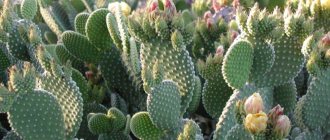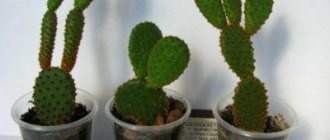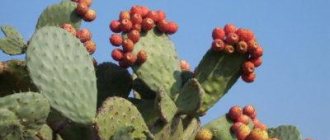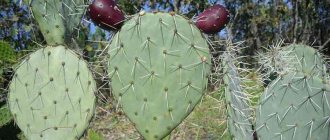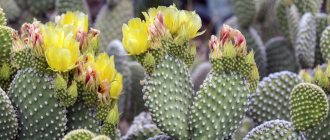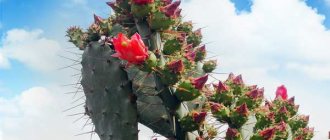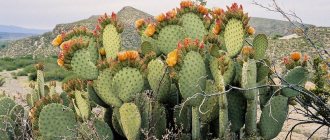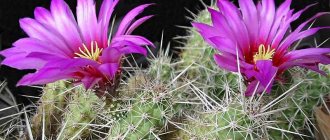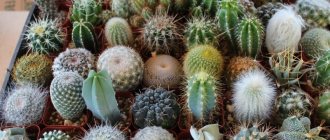Prickly pear is a true legend among cacti. It is no coincidence that perhaps the most famous cactus on our planet was chosen for school experiments that introduce the amazing talents and structure of cacti. Even today, prickly pear does not lose its industrial importance. However, it is rapidly losing its former popularity. Due to their growth rate and size, prickly pears have almost disappeared from our interiors, even despite the emergence of new interesting varieties. The ease of formation and control, as well as the variety of prickly pears, are too often unfairly ignored. But the special beauty of representatives of the amazing genus Opuntia deserves more than decoration for biology classrooms.
Prickly pear - a legend among cacti
Description of the plant
The appearance of prickly pears (Opuntia), forming bizarre thickets and figures, is almost inseparable from Mexican landscapes (so much so that prickly pear is even present on the national coat of arms). This is a historically valuable and ancient cultivated species, which was already used for food and as a forage plant thousands of years ago. But this does not at all negate the decorative nature of prickly pears.
This cactus became famous for its special segmentation of stems. Articulated shoots are flat, disc-shaped, most often oval or almost round, less often cylindrical, branch and form huge bushes over time. It is impossible to predict where exactly the segments will develop, in which direction and from which “point” a new segment will begin to grow, which makes the prickly pear a star full of surprises.
The very thick skin protects the juicy pulp of the shoots. Old stems gradually become woody and a light brown crust appears on them. Prickly pears also have reduced cylindrical leaves, which are clearly visible on young shoots. In nature, prickly pears grow up to 2-4 m in height, but in a room they rarely reach even 1 m.
The spines of prickly pears are very dangerous. Moreover, large, hard true spines are not as traumatic as the small, sharp glochidia surrounding the areoles with jagged edges. They are easily separated from the stem and difficult to remove from the skin, so it is better to handle this cactus more carefully. In animals, glochidia cause severe irritation when ingested.
The flowering of prickly pears is very spectacular. Red, yellow or orange, short, simple flowers located on the side of the segments appear dazzlingly bright. Unfortunately, most often the flowering of prickly pear remains just a dream, because prickly pears bloom at an advanced age and when they reach large sizes, almost impossible in an indoor format.
White-haired prickly pear (Opuntia leucotricha). © marasri
Recommendations
- K. Michael Hogan. 2011 Cactus. Topic ed. Arthur Dawson. Editor-in-Chief Cutler J. Cleveland. Encyclopedia of the Earth. National Science and Environment Council. Washington, DC
- Gorelick, R. 2015. The northern limit of the range of Opuntia fragilis
and Cactaceae is 56°N rather than 58°N.
Madroño
62(2):115-123. - Mottiar Y., P.D.J. Chafe and Eric Ribbens. 2015 Imperfect flowers of Opuntia fragilis
in Caladar, Ontario.
Haseltonia
20:22-25. - Haw.[ clarification needed
]
Types of indoor prickly pears
Prickly pears may be strikingly similar, but you can't blame them for a lack of variety. The presence of three hundred species makes prickly pear the largest genus among cacti. Most of them are too gigantic for indoors, but several species have successfully adapted to growing in pots.
White-haired prickly pear (Opuntia leucotricha) is a neat cactus with elongated fleshy oval stems and a dark green color, famous for its densely spaced white areoles with hair-like spines up to 5 cm long, appearing on older segments.
Berger's prickly pear (Opuntia bergeriana) is a large species with irregular flat discs of matte green segments up to 25 cm long and very large brown spines in sparsely spaced areoles.
Small-haired prickly pear (Opuntia microdasys) is a compact species, up to half a meter tall, with elongated ovals of fairly thick segments that look massive. Large and round, the areoles with bright glochidia appear as densely spaced dots - miniature bunches of white, yellow or red mini-spines.
subulata is an unusual species with cylindrical, vertically growing shiny, bright green segments, long-lasting protruding reduced tube leaves, yellow spines and white hairs.
Berger's prickly pear (Opuntia bergeriana). © ESTO jarelmaks
Opuntia microdasys. © Elie Mouawad
Opuntia subulata. © CStone2005
Opuntia articulatus is an interesting species with lumpy, thickened dark gray segments and unusual flat, paper-like, slightly curved, non-thorny spines up to 5 cm long.
Prickly pear (Opuntia fragilis) is a ground cover species with rounded, thickened, small segments that are naturally highly branched. The maximum length of segments is up to 3 cm. White halos with yellowish spines seem too rough for such a large cactus.
vestita is an interesting species with cylindrical shoots forming intricately branching trunks, densely covered with fine white hairs.
Opuntia articulatus. © uhlig-kakteen
Opuntia fragilis. © palmbob
Opuntia vestita. © Scido
Tuna prickly pear (Opuntia tuna) is an interesting species with flat, densely branched shoots of a rich green hue in bizarre silhouettes.
Long-awned prickly pear (Opuntia longispina) is a creeping, naturally compact species with light disc-shaped segments up to 4 cm in length, very densely spaced areoles with 3-5 long white needles.
Gosselin's prickly pear (Opuntia gosseliniana) is a squat, densely branched species with perfectly round disks of segments with a grayish coating, against which the bright crimson young needles appear dazzling.
Species plants are now being replaced by a variety of varieties - with colored spines, variegated young leaves, purple and metallic effects. Particularly compact and interesting are coral-shaped cristates and densely branching monsters.
Tuna prickly pear (Opuntia tuna). © semiramis78
Long-awned prickly pear (Opuntia longispina). © John Gamesby
Gosselin's prickly pear (Opuntia gosseliniana). © fearlessthereforepowerful
Description
Opuntia fragilis
is a small pendulous plant, rarely more than 10 cm (4 in) in height: joints swollen, brittle, easily separated, oval, elliptical or hemispherical, 3-5 cm (1-2 in) long and almost as thick , like the width. , bright green: areoles 0.6–1.3 cm (1⁄4–1⁄2 in) detached, with whitish hair and several white or yellow setae that are much longer and larger on older joints; spines 1–4, sometimes a few small additional ones, weak, dark brown, the top one is usually longer and stronger than the others, rarely 2.5 cm (1 in) long: flowers greenish-yellow, 2.5–3.2 cm (1 –1 1⁄4 c) broad: the fruit is ovoid-globose, with few spines or setae, mostly sterile, 2.5 cm (1 in) or less in length; seeds are few and large.[4]
Growing conditions for indoor prickly pear
The warmest, brightest window is the ideal location for this unusual cactus. A special wintering is needed only for flowering plants.
Lighting and placement
Prickly pears require the brightest possible lighting and cannot tolerate even slight shading, especially bright varieties. Western, eastern, southern window sills are the only options for maintaining compactness and dense branching. It is not necessary to increase the lighting for prickly pear in the winter, but if the cactus remains in the same place, in the spring it must be carefully accustomed to bright lighting, protecting it from direct sun for several weeks.
Prickly pears are not afraid of rearrangements, but not during the budding period. Even a slight fluctuation in conditions and turning can cause a massive drop of all the buds.
Links[edit]
- C.Michael Hogan. 2011. Cactus. Topic ed. Arthur Dawson. Editor-in-Chief Cutler J. Cleveland. Encyclopedia of the Earth. National Science and Environment Council. Washington, DC
- Gorelick, R. 2015. The northern range limit of Opuntia fragilis
and Cactaceae is 56°N rather than 58°N.
Madroño
62(2):115–123. - Mottiar Y., PDJ Chafe and Eric Ribbens. 2015. Imperfect flowers of Opuntia fragilis
in Caladar, Ontario.
Haseltonia
20: 22-25. - Haw. [ clarification needed
]
Caring for prickly pear at home
Prickly pears must be handled very carefully, protecting the easily falling spines from accidental touches. Due to glochidia, cleaning the plant is a huge problem, but hygiene and the absence of dust remain one of the keys to the health of the cactus, along with careful watering.
Watering and air humidity
There is only one difficulty in watering prickly pears - the stems should not be soaked under any circumstances. It is precisely because of the extreme tendency to rot that if watered inaccurately, prickly pear is easier to water through a tray, because constantly making sure that water gets only along the edge of the pot is not always convenient. Prickly pears are actively growing; they are large cacti, so they need to be watered generously, draining off excess water and allowing the soil to dry out on top. In summer, prickly pears love evening watering.
During the dormant period, if the plant is sent to a cool place, it is better to stop watering completely. When wintering in a warm place, they are simply kept minimal and supportive (about once a month).
Top dressing and fertilizer composition
You only need to add a standard dose of fertilizer to the water in spring and summer. For prickly pear, 1 feeding per month is enough.
You can use not only special fertilizers for cacti and succulents, but also other fertilizers with a reduced nitrogen content (the standard dosage can simply be reduced several times). Prickly pear is extremely sensitive to excess nitrogen. It is better not to experiment with organic fertilizers.
Pruning and shaping prickly pear
This cactus can be shaped at your discretion - remove segments that lead to loss of compactness and elongation, are underdeveloped or damaged, tie up, update with radical pruning, or replace with young cacti. The segments are easy to separate; cutting is not necessary. The main thing is not to forget to treat the wounds, allowing them to dry thoroughly.
Prickly pears are transplanted with a dry earthen ball and are not watered after transplantation.
Transplantation, containers and substrate
Only young cacti need frequent replanting; adult prickly pears are transplanted in early spring in those years when there are signs of a lack of space for root development.
Prickly pears require stable containers. Unlike many cacti, prickly pears, when growing, can be planted in deep and spacious pots that are more suitable for their spreading nature and unpredictable branching.
It is better to choose an earth mixture from among special substrates for cacti. Prickly pears prefer slightly acidic soils. Water permeability is a key parameter; the soil must contain coarse sand and other disintegrants.
Prickly pears are transplanted with a dry earthen ball and are not watered after transplantation. It is better to compensate for stress by placing it in a warm, semi-shaded place. Only after a week, giving the plant time to adapt, watering and usual care are resumed.
Diseases, pests and problems in growing
Prickly pears often suffer from lack of light, wetting, overwatering, reacting by wrinkling and the appearance of soft spots of rot, stretching, deformation, stunting of growth, and very often by drying out or dropping young segments. Spider mites, scale insects and other pests are sometimes found on them, but, as a rule, only on old cacti suffering from lack of light. When pests appear, it is better to immediately begin treating with insecticides.
Prickly pears are easy to grow from cuttings
